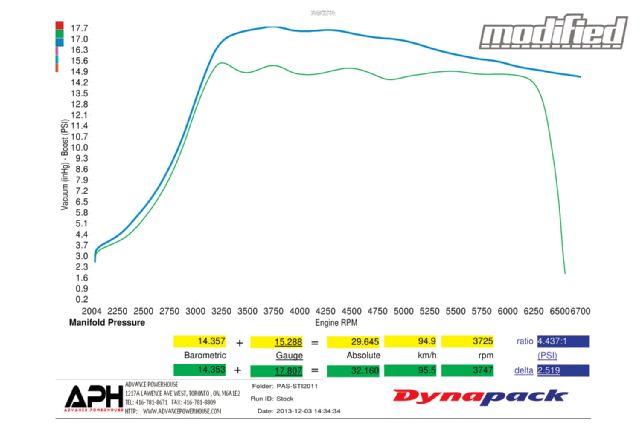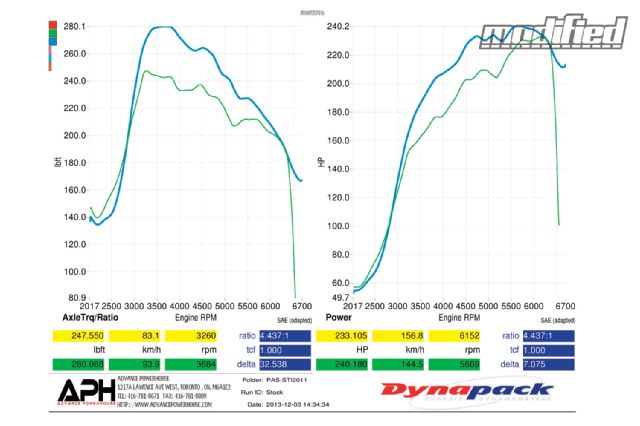Test Mule
2011 Subaru Impreza STI
Engine
EJ25DET turbocharged flat-four
Relevant Mods
None
Key Features
- Larger, full-color, high-resolution screen
- Full text help menus and full map descriptions
- Customizable multi-gauge display
- In-car mount, on/off switch, and removable faceplates
- New processor flashes more than 50 percent faster and boots up more than 30 percent faster
- More storage space for maps and up to 10 hours of datalogging
- Fully compatible with earlier version maps and software
 | The V3 comes in a nice carrying case and includes two faceplates (blue and silver) as well as the necessary cables to hook it up to your car’s ODB-II diagnostic port and a laptop.
| The V3 comes in a nice carrying case and includes two faceplates (blue and silver) as well as the necessary cables to hook it up to your car’s ODB-II diagnostic port and a laptop.
Description
Cobb Tuning’s AccessPort has got to be one of the most tried-and-true ECU reprogramming tools in the history of import tuning. First released back in 2004, the handheld AccessPort took the turbocharged Subaru world by storm, allowing its end users and professional tuners to design custom maps for optimized power, driveability, and efficiency while retaining OEM tuning logic and safety checks.
A huge part of the appeal of the AccessPort has always been its simplicity, both in terms of installation (plugs into the OBD2 diagnostic port) and its intuitive and simple controls and interface. But time marches on and the V2 screen and text interface were starting to look pretty old school, something the new V3 addresses very nicely with a much larger, full-color and high-resolution screen (approximately three times the size of the V2 screen). As a result, the V3 has grown in overall size, but it’s still no larger than an iPhone and looks totally at home mounted on the dash (and comes with a very nice carrying case if you prefer to store it away in the glovebox).
 | The larger, full-color screen makes the new Cobb AccessPort V3 an even more versatile product, now that it can be used as a gauge display.
| The larger, full-color screen makes the new Cobb AccessPort V3 an even more versatile product, now that it can be used as a gauge display.
The logic behind the move to a larger screen and the included dash mount becomes entirely clear once you install the V3 and start to play around with the customizable gauge display. Suddenly the AccessPort isn’t just a powerful ECU reprogramming device and diagnostics tool, it’s now also a gauge cluster capable of displaying any of the engine’s parameters—including boost pressure, air/fuel ratio, throttle position, and any other data signals the ECU sees. You can opt to display between one and six gauges, so you have a huge amount of flexibility in terms of information displayed. And you can quickly and easily change the setup so you can, for example, switch back and forth between a street-oriented setup and a track-day setup.
Of course, the AccessPort’s core function as an ECU recalibration tool is still very much at the heart of the V3, given that it comes loaded with all the available off-the-shelf (OTS) maps for Cobb’s heavily tested staged upgrade paths. It’s also completely compatible with Accesstuner Race for you DIY tuners and Accesstuner Pro. Within Tune mode, there’s also a new menu item that allows you to separately adjust the idle speed, retard ignition timing (as a response to a tank of bad gas, for example), change the launch control and flat-foot shift rpm, or revert to the factory defaults for launch control and flat-foot shifting, all without having to change the main map itself.
 | The larger, full-color screen makes the new Cobb AccessPort V3 an even more versatile product, now that it can be used as a gauge display.
| The larger, full-color screen makes the new Cobb AccessPort V3 an even more versatile product, now that it can be used as a gauge display.
Results
We borrowed a friend’s completely stock ’11 STI hatchback for a quick dyno test, just to see how the Stage 1 OTS map performs compared to the factory tune. Turns out Subaru played it awfully safe with its tuning, because Cobb’s Stage 1 map picked up huge midrange power and torque gains from 3,000 to 6,000 rpm, as you can see from the results we got on Advance Powerhouse’s in-house Dynapack hub dyno. Peak gains of 33.5 lb-ft and about 7 whp only tell a small part of the story, since the area under the curve gains in the midrange is massive but trails off at higher rpm as the Cobb map begins to trim boost pressure back to the stock level to protect the engine. But prior to that, boost pressure ramps up to maximum boost pressure of 17.8 psi at 3,750 rpm with the Stage 1 tune, versus a max boost reading of 15.5 psi at 3,250 rpm with the stock map.
Although the increased boost pressure is responsible for most of the power gains, it’s clear that Cobb Tuning has also refined fuel and ignition timing, given how both the torque and horsepower curves are smoother than the stock curves. And both the car owner and I agree that the data collected on APH’s dyno plays out quite dramatically in the real world, where this STI feels way stronger, especially in the midrange during typical blasts at full throttle to dispatch slower moving traffic.
As Andy the owner put it, “This off-the-shelf tune goes way beyond just cranking up the boost. It gave me a smoother powerband and more torque in all the right places for a daily driver. Midrange torque is addictive, turbo lag is unnoticeable, and throttle roll-on is linear. When creeping in First gear gridlock, the car has smoother power and is much less jerky under the foot. Also, any STi owner will tell you about an annoying 2,500-rpm ‘bump’ in the powerband, which Cobb has managed to solve.”
 | Engine RPM Graph
| Engine RPM Graph
Gains Made
+ 7 whp
+ 32.5 lb-ft
Before 233 whp and 247.5 wtq
After 240 whp and 280 wtq
 | Dynograph
| Dynograph

